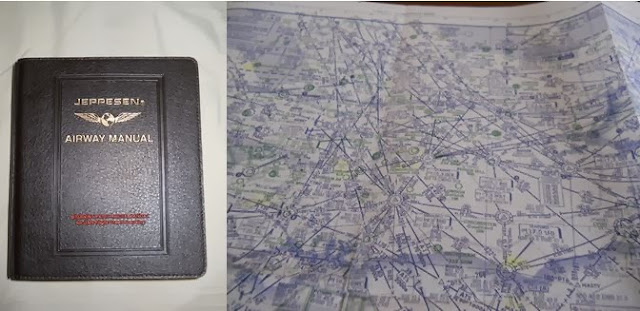Another week has ended and more knowledge has been consumed. This week we have been studying General Navigation, a topic based on calculations navigating us around the globe from A to B. So it's all pretty important stuff. Now that the topics are more practical, we have been given the Jeppesen Airway Manual. This hefty binder contains all the charts that we need to complete the exams. There is a range of charts in this manual including airway (motorways of the sky) charts and airport charts showing taxiways, terminals and gates.
 |
| Jeppesen airway manual and one of the included low level airway charts |
The majority of what we have done so far has been learning about longitude and latitude, Great circles (the shortest distance across the globe) and rhumb lines (lines that cross each meridian at the same angle). This involves looking at different types of charts and the various properties of each one. This all becomes of use when working out where we are and where we need to go. In the picture above you can see some thick lines criss-crossing seemingly randomly across the page. These lines are in fact airways and follow great circle lines from radio-navigation aids. In light aircraft with basic equipment these lines and angles aren't the ones displayed on the instrument so we need to know how to convert them to useful headings and bearings for us to navigate accurately. The modern highly automated aircraft that I will be flying day to day will do all of this for me, but during training, in light aircraft, flight planning and when it all goes wrong this knowledge will probably come in quite handy.
 |
| The CRP-5 |
We have also started learning how to use the CRP-5 flight computer. It's affectionately know as the "crap 5", but in all honesty its a brilliant piece of equipment that saves time on numerous calculations such as fuel unit conversions and wind, velocity, track and heading calculations. At first it's quite a daunting thing to use but like most things once you get the hang of it, it becomes far easier and far more useful. It's also known as a whizz wheel because the centre of it rotates enabling the plethora of calculations that it is capable of. Admittedly its not as accurate as a calculator, but its much quicker and the value obtained is close enough to real answer for it to be used in flight.
We have another week of this before moving on, so until then Adios!



